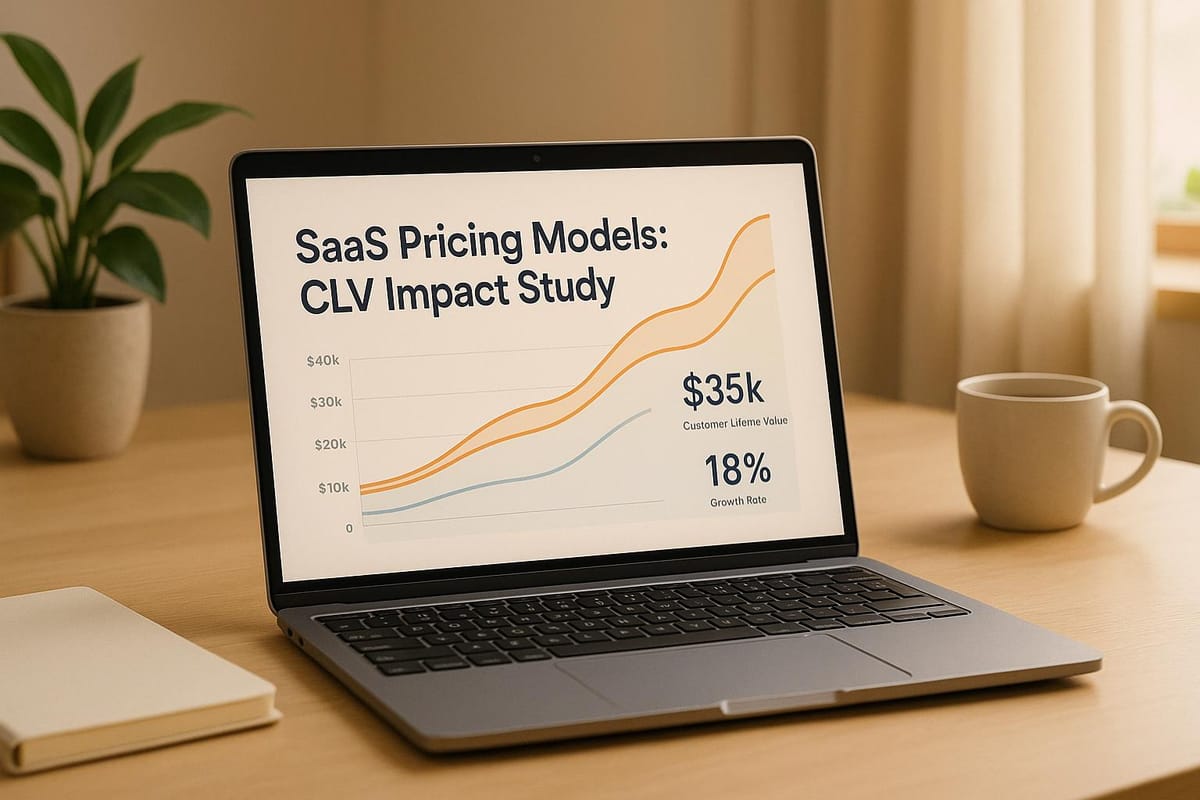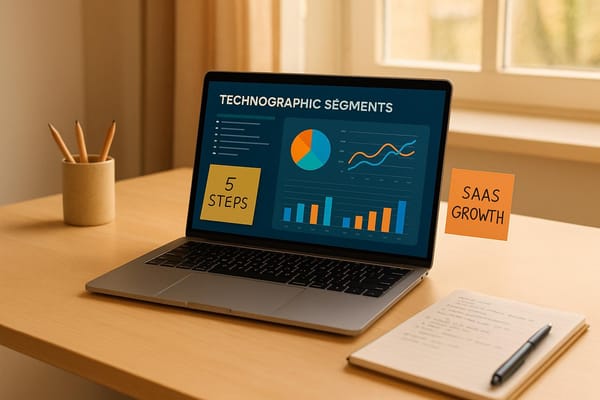SaaS Pricing Models: CLV Impact Study
Explore how SaaS pricing models impact customer lifetime value and business growth, highlighting key strategies for optimizing revenue.

Key Insight: The right SaaS pricing strategy can significantly boost profits, reduce churn, and maximize customer lifetime value (CLV). Even a 1% improvement in pricing can lead to an 11% increase in profits.
Key Takeaways:
- Pricing Models Matter: Tiered, usage-based, and hybrid pricing models directly affect customer acquisition, retention, and revenue growth.
- Value-Based Pricing Wins: Companies using value-based pricing grow 30% faster and reduce churn by 19% compared to cost-plus pricing.
- Premium Pricing Reduces Churn: SaaS businesses with higher price points (>$100,000 ACV) report churn rates of 6–10%, compared to 10–15% for lower-priced offerings.
- Usage-Based Models Drive Growth: Companies with usage-based pricing report 17% faster annual revenue growth than the industry average.
- Hybrid Models Excel: Combining subscription and usage-based elements results in the highest median growth rate (21%) among SaaS pricing strategies.
Quick Comparison of Pricing Models:
| Model | Key Features | Impact on CLV | Examples |
|---|---|---|---|
| Tiered Pricing | Multiple packages at various price points | Boosts LTV by 30% | Zendesk, Mailchimp |
| Usage-Based | Charges based on usage | 50% lower churn, faster growth | Twilio, Datadog |
| Hybrid Pricing | Combines subscription + usage-based | 21% growth rate, scalable | HubSpot, Adobe |
Why It Matters:
Pricing isn’t just about revenue - it’s about aligning costs with value. Companies that refine their pricing strategies enjoy 38% higher revenue growth and 15-25% gross profit increases within a year. Start by understanding your customer’s perceived value and tailor pricing to match.
Keep reading for actionable insights on how to optimize your SaaS pricing for long-term growth.
Value-Based Pricing: Lessons from 20k+ SaaS Companies - Patrick Campbell, Founder & CEO, ProfitWell
How Pricing Models Affect CLV Metrics
The connection between pricing models and Customer Lifetime Value (CLV) isn’t just theoretical - it shows up in real numbers, impacting key business areas like customer acquisition costs, retention rates, and opportunities for revenue growth. Getting your pricing strategy right can be the difference between steady growth and losing customers to churn.
Impact on Customer Acquisition Cost (CAC)
Your pricing model has a direct effect on customer acquisition costs (CAC). For instance, every 1% increase in price tends to reduce conversion rates by about 0.6% [3]. This effect becomes even more noticeable in different market segments. Enterprise deals with annual contract values (ACV) over $100,000 can take three to four times longer to close than deals with small or medium-sized businesses (SMBs), which drives up acquisition costs by two to three times [3].
A great example of managing CAC through pricing is Slack. By offering a free tier, they made it easy for users to try their product and eventually upgrade, which reduced sales friction and kept acquisition costs low while fueling organic growth. Over time, they adjusted their pricing tiers to boost revenue without significantly increasing CAC [3]. This balance is crucial, especially when it comes to retention.
Pricing and Churn Rate Connection
Pricing strategies also have a major influence on customer retention. For companies with higher price points (over $100,000 ACV), annual churn rates typically fall between 6% and 10%. In contrast, businesses with lower price points ($1,000–$25,000 ACV) often face churn rates ranging from 10% to 15% [3]. This highlights how premium pricing, when paired with clear value, can help reduce churn.
Price fairness matters too - 78% of customers say they prioritize fair pricing when choosing a company [5]. Billing frequency also plays a role: annual billing tends to retain customers 30% better than monthly billing [4]. Usage-based pricing models, which align costs with the value customers receive, often achieve 5–10% higher net revenue retention compared to flat-rate pricing [4]. Transparency is another key factor; companies with clear pricing structures see 18% higher retention rates than those with opaque pricing [4]. SaaS companies that tie their pricing to measurable customer value experience 50% lower churn rates [3]. All of this shows how thoughtful pricing can lower churn while setting the stage for future growth.
Driving Expansion Revenue Through Pricing
Once acquisition and retention are optimized, pricing can also fuel expansion revenue - a critical driver of SaaS growth. Among top-performing SaaS companies, 62% of new monthly recurring revenue comes from expansion efforts, which is 4.4 times more than what smaller, lower-performing companies achieve [7]. For mature SaaS businesses, expansion strategies can contribute 20–30% of total annual recurring revenue [3].
Tiered pricing models are particularly effective for driving upgrades. For example, running quarterly pricing tests can accelerate growth by two to three times [6]. Adobe’s shift from perpetual licensing to a subscription-based model with Creative Cloud is a prime example. This move not only improved their gross margin by about five percentage points (from 85% to 90%) but also created a more predictable revenue stream [3]. Even small pricing adjustments can have a big impact - a 1% improvement in pricing can lead to an 11% increase in operating profit [6]. Additionally, SaaS companies using usage-based pricing often trade at 8–10 times higher revenue multiples compared to those relying solely on subscription models [6].
In short, a well-designed pricing strategy doesn’t just lower acquisition costs and reduce churn - it also opens up opportunities for expansion revenue, helping you build a more sustainable and scalable business model.
Comparison of Popular SaaS Pricing Models
Choosing the right pricing model - whether tiered, usage-based, or hybrid - plays a key role in boosting customer lifetime value (CLV). Each model comes with its own strengths, shaping customer acquisition, retention, and revenue growth in distinct ways.
Tiered Pricing
Tiered pricing offers multiple packages, each with unique features and price points, and has been shown to drive 30% higher lifetime value (LTV) compared to simpler models [3]. This structure provides predictable revenue and plenty of opportunities for upselling.
Take Zendesk, for instance. Their non-enterprise plans include options like the Team tier at $49 per agent per month (billed annually), the Growth tier at $79 per agent per month, and the Professional tier at $99 per agent per month [14]. Mailchimp takes a slightly different approach by linking its tiers to usage. Their Free plan includes 1,000 email sends per month, while the Essentials plan starts at $13 per month for 5,000 sends. The Standard plan costs $20 per month for 6,000 sends, and the Enterprise plan begins at $350 per month, accommodating up to 150,000 sends [14].
The beauty of tiered pricing lies in its ability to attract a broad audience by addressing diverse needs while making revenue and cash flow more predictable [14]. However, other models offer unique advantages that may better suit certain business goals.
Usage-Based Pricing
Usage-based pricing, where customers are charged based on how much they use, is gaining traction. It’s used by 46% of SaaS companies [10] and has been linked to faster annual revenue growth (17% compared to the industry average of 13%) [10]. Companies using this model also report net dollar retention rates about 10 percentage points higher than those sticking to standard subscription models [12].
The benefits are clear in real-world examples. When Landbot adopted usage-based pricing, their net revenue retention jumped by 26% [13]. Austin Yang, Former Lead Product Manager at Landbot, highlighted the potential of this approach:
"Pricing changes are always risky, but the risk-to-reward ratio of usage-based pricing is asymmetric – which is likely what makes monetization the most effective growth pillar." [13]
Similarly, Datadog saw success with this model. Scott Buxton, their former VP of finance, noted that usage-based pricing lowers barriers to adoption and encourages consistent use [13]. By tying costs directly to value, this model enhances customer loyalty. However, it does come with a downside: revenue can fluctuate, so careful monitoring is essential.
For SaaS companies seeking a balance between stability and adaptability, hybrid pricing models offer an appealing solution.
Hybrid Pricing Models
Hybrid pricing blends the predictability of subscriptions with the flexibility of usage-based billing. According to the 2025 SaaS Pricing Trends Report, hybrid models boast the highest median growth rate at 21% [8]. Among high-growth SaaS companies (those with over 40% annual growth), 61% have already embraced this approach [11].
HubSpot is a standout example of hybrid pricing in action. In 2011, they integrated usage-based elements into their subscription pricing. By 2021, HubSpot’s revenue had soared to $1.3 billion [12]. This shows how hybrid models can scale effectively while maintaining strong growth and retention.
As Jenny Millar, Founder of Untapped Pricing, observed:
"We're in this period of high inflation and economic volatility, so an increasing number of SaaS businesses are shifting away from traditional, flat-rate subscription models to usage-based, or value-based, models. And I think that's the reflection of the changing needs of SaaS users." [9]
Companies using hybrid models often outperform their peers. Usage-based SaaS businesses, for example, have seen revenue growth rates 54% higher than the broader SaaS index [13]. Hybrid pricing delivers steady income for vendors while offering customers the flexibility they crave [8]. That said, successful implementation requires careful planning. Automated billing systems, clear communication of pricing, and well-defined value metrics are all essential [8].
New Trends in SaaS Pricing Strategies
SaaS companies are moving away from traditional pricing methods, embracing strategies that focus on increasing customer lifetime value (CLV) through smarter analytics and tailored customer experiences.
Value-Based Pricing for High CLV
Value-based pricing sets prices based on the perceived value of a product or service rather than its cost. This approach has been a game-changer for many SaaS companies. In fact, those adopting value-based pricing see growth rates that are 30% higher than competitors using cost-plus models [2].
The benefits don’t stop there. Companies leveraging this strategy report, on average, 19% lower churn rates [16] and 54% higher net revenue retention [16]. Why? Because when customers feel they’re getting substantial value for what they’re paying, they’re far less likely to cancel their subscriptions [2].
Take Salesforce, for example. They’ve mastered this model by offering tailored plans for different customer segments. From their Essentials plan for small businesses to their Unlimited plan for large enterprises, each tier is designed to match the unique needs and value expectations of its users. This customer-focused strategy has played a major role in Salesforce becoming a leader in the CRM market [15].
Similarly, Slack structures its pricing tiers around value rather than just listing features. Their free plan works well for small teams, while the Standard and Plus plans cater to growing businesses and larger organizations. This thoughtful tiering has been a key factor in Slack’s rapid expansion and high customer satisfaction [15].
Companies that frequently re-evaluate their value metrics also see profit margins improve by 3–8% within the first year [2]. Wistia, a video hosting platform, is a great example. They introduced a Pro plan with advanced analytics and integrations, which appealed to customers who recognized the added value, helping Wistia boost both customer acquisition and retention [15]. Building on these successes, many SaaS companies are now exploring dynamic pricing models that adapt in real time.
Dynamic Pricing Models with Predictive Analytics
AI is reshaping how SaaS companies approach pricing. Dynamic pricing, powered by predictive analytics, uses data on customer behavior, competitor trends, and perceived value to adjust prices in real time. This approach not only optimizes revenue but also helps maintain customer satisfaction [18].
For instance, one analytics SaaS company boosted its average revenue per user by 15% through predictive pricing models [21]. Another platform managed to cut churn by 20% in just six months by using predictive tools to identify at-risk customers and offer personalized interventions [21].
One standout example involves a project management SaaS company that adopted AI-driven pricing tools. By identifying customers likely to churn and adjusting pricing accordingly, they reduced churn by 18% within six months. At the same time, they increased average revenue per user by 22% and boosted CLV by 15% through targeted upselling [20].
These AI models work by analyzing key data points - such as demand trends, competitor pricing, and customer behavior - to find the best price points and predict potential upgrades or expansions [38, 41]. This proactive approach helps SaaS companies address pricing challenges before they lead to customer loss.
"Data is a critical resource, but only when used intelligently."
- Foster Provost and Tom Fawcett [19]
To get the most out of these models, companies need to continuously monitor their performance and fine-tune their algorithms over time [17]. Alongside real-time pricing adjustments, many SaaS businesses are leveraging freemium models to build stronger customer relationships and drive enterprise-level conversions.
Freemium-to-Enterprise Pathways
The freemium model has evolved into a powerful tool for nurturing long-term enterprise relationships. While traditional freemium-to-premium conversion rates hover around 5%, free trials see a higher average conversion rate of 17% [22]. However, the true strength of the freemium model lies in its ability to create extended customer journeys and foster trust over time.
Grammarly is a prime example of this strategy's potential. After adopting a freemium model in 2015, the company grew from 1 million daily active users to 30 million by 2020 [22]. This massive user base provides a strong foundation for converting high-value enterprise clients.
Freemium models work by offering users a chance to experience the product’s core benefits, building trust and dependency over time. This extended engagement helps companies identify power users and organizations with enterprise potential, allowing them to craft targeted strategies for conversion.
Strategic limitations in the free plan can also encourage upgrades. For instance, offering premium features that far exceed the free version’s capabilities - and regularly updating those features - keeps the paid plans appealing [23]. Providing robust support across all user tiers is equally important. While premium users may enjoy enhanced support, assisting free users fosters goodwill and reinforces the company’s commitment to customer success [23].
Finally, targeted marketing based on user behavior can significantly improve conversion rates. Personalized upgrade messages are far more effective than generic prompts, helping businesses drive higher CLV and strengthen customer relationships [23].
Step-by-Step Guide for CLV-Driven Pricing
Maximizing Customer Lifetime Value (CLV) isn't just about crunching numbers - it requires the right systems, team collaboration, and a commitment to ongoing adjustments. Companies that align their pricing strategies with their go-to-market approach enjoy 38% higher revenue growth [24], making this a critical focus for sustainable success.
Building the Right Infrastructure
To make smarter pricing decisions, start with systems that track how customers interact with your product. Tools that segment users by usage, size, industry, or growth patterns are invaluable. Pair these with analytics platforms that provide real-time insights into key metrics like ARPU (Average Revenue Per User), CAC (Customer Acquisition Cost), churn, and conversion rates [25].
Go a step further by adopting value metric frameworks - these track not just how much your product is used, but how it delivers measurable results for customers. For example, technical founders often create custom dashboards that translate raw usage data into business outcomes.
Your infrastructure should also support A/B testing for pricing experiments. Testing different price points, packaging options, or value propositions can reveal what resonates best with your audience and help optimize conversion rates and ARPU [25].
Once you have the data, make sure it’s shared across teams. A unified approach allows everyone to work toward the same pricing goals.
Aligning Sales and Marketing Teams
Here’s a challenge: nearly 70% of SaaS companies admit their pricing and go-to-market strategies operate in silos [24]. Breaking down these barriers is essential for maximizing CLV.
One way to bridge the gap is by forming a cross-functional pricing council. Include representatives from product, marketing, sales, finance, and customer success. Research shows that companies with such councils achieve 25% higher returns on pricing [24]. This group should meet monthly to review performance, gather market feedback, and adjust strategies as needed.
Equip your sales and marketing teams with joint value-selling tools they can use consistently. These might include ROI calculators, competitive battle cards to handle objections, and case studies showcasing how your product delivers results. Pricing objection playbooks are also helpful for guiding sales conversations [24].
Training is another key ingredient. Your teams need to understand not just the numbers behind your pricing but the reasoning. They should be able to explain how your pricing structure delivers value tailored to different customer segments.
A great example of alignment comes from Datadog. Between 2018 and 2022, they focused their entire organization on "monitored hosts" as a value metric. Marketing emphasized the benefits of complete infrastructure visibility, while sales highlighted the ROI based on the number of monitored hosts in a prospect’s environment. This alignment helped Datadog grow from $100 million to over $1 billion in revenue in just four years [24].
Finally, set up feedback loops between teams. Use win/loss analyses, pricing perception surveys, and competitive intelligence to track progress. Monitor shared success metrics like reduced discounting, faster sales cycles, higher expansion revenue, and improved CLV [24].
"The most successful SaaS companies don't just have great products or clever pricing - they have seamless alignment between how they create value, price that value, communicate that value, and ultimately deliver that value." - Patrick Campbell, Founder of ProfitWell (acquired by Paddle) [24]
This kind of teamwork lays the foundation for continuous improvement.
Monitoring and Adjusting Pricing Models
75% of companies admit they don’t fully leverage data and analytics in their pricing strategies [25]. To stay ahead, you need to monitor and refine your pricing model constantly.
Automate the tracking of critical CLV metrics like ARPU, CAC, churn, and conversion rates. Break these down by customer segment, pricing tier, and acquisition channel. Real-time dashboards can help you identify trends and address issues before they escalate.
Customer feedback is just as important as hard data. Surveys, interviews, and in-app prompts can reveal how customers perceive your pricing. These insights often highlight pain points that raw numbers might miss [25].
A/B testing is another powerful tool. Experimenting with pricing pages, in-app messaging, or upgrade prompts can lead to incremental improvements. For instance, even a 1% boost in monetization can increase overall profits by 12.7% [1].
Keep an eye on your competitors and industry trends. Pricing strategies should adapt to market changes while staying focused on CLV optimization [25].
One software company working with Revology shifted from a flat-rate pricing model to a hybrid structure combining tiered and usage-based pricing. The result? A 30% increase in recurring revenue and a 25% improvement in customer satisfaction, as clients appreciated the flexibility [25].
Companies that treat pricing as an ongoing process, rather than a one-time decision, often see 15-25% gross profit increases within the first year [25]. To keep your strategy fresh, plan to reassess your pricing every six months [1].
Conclusion: Key Insights and Next Steps
Research highlights that pricing is a major driver of sustainable growth for SaaS companies. Businesses that treat pricing as a strategic tool consistently outperform their competitors across critical metrics.
Recap of Pricing Model Comparisons
Different pricing models offer unique ways to maximize Customer Lifetime Value (CLV):
- Tiered pricing models can boost LTV by 30% compared to simpler structures [3]. By offering natural pathways for customers to expand their usage, these models grow alongside customer success.
- Usage-based pricing aligns directly with customer value. Companies using this approach see 50% lower churn rates when pricing reflects tangible value realization [3]. This model is especially effective for technical products where usage directly impacts business outcomes.
- Hybrid pricing models blend steady base revenue with usage-based growth opportunities. This balance allows companies to capture both predictable income and expansion potential.
The data also reveals that value-based pricing consistently outperforms cost-plus models, enabling businesses to achieve 10–15 percentage points higher gross margins and 30% faster growth rates [3][2]. While value-based pricing requires a deeper understanding of customer needs, it delivers far better unit economics.
These findings emphasize how pricing models directly impact CLV, providing a foundation for more strategic decision-making.
Final Thoughts on CLV-Focused Pricing
What sets successful SaaS companies apart? They recognize that pricing is the bridge between creating value and capturing it [3]. Pricing isn't just a marketing decision - it's a core driver of long-term profitability.
Most SaaS companies leave revenue on the table. Even a small adjustment - like a 1% improvement in pricing - can boost profits by 11% [2]. Regular pricing reviews, conducted annually, lead to 30–40% faster growth compared to "set it and forget it" strategies [3]. These reviews ensure pricing keeps pace with customer value and market changes.
Savvy technical founders understand that pricing impacts everything: customer acquisition costs, product development priorities, and the market segments they can serve effectively.
Call to Action
The next step in transforming your pricing strategy starts with understanding how your product creates measurable value for customers. From there, you can design a pricing model that captures that value effectively.
For technical founders and engineering-led companies, High-Growth Digital's 90-Day Brand Implementation Sprint offers a practical framework to help you make this shift. Their specialized process focuses on identifying value metrics, crafting compelling pricing structures, and building systems for sustainable growth.
This sprint is particularly helpful for companies in industries like biotech, AI/ML, enterprise SaaS, and health technology - fields where technical complexity can obscure customer value. The program emphasizes translating technical capabilities into clear customer benefits, developing aligned pricing, and creating marketing tools to communicate your worth.
The payoff is clear: optimized pricing strategies can increase gross profit by 15–25% within the first year [25]. The real question isn't whether you can afford to refine your pricing - it’s whether you can afford not to.
Visit High-Growth Digital to learn how their 90-Day Brand Implementation Sprint can help you unlock sustainable growth and maximize Customer Lifetime Value.
FAQs
Why does value-based pricing help SaaS companies grow faster and reduce churn?
Value-based pricing allows SaaS companies to grow faster and keep churn rates in check by aligning pricing with the value customers see in the product. When customers feel they’re paying for clear, measurable benefits, their satisfaction and loyalty naturally increase.
Research backs this up: companies that adopt value-based pricing often grow up to 30% faster compared to those sticking with cost-plus models. Plus, this approach helps reduce churn since customers are more likely to stick around when they believe the value they’re getting is worth the price they’re paying. By prioritizing what matters most to customers, value-based pricing not only builds stronger, long-term relationships but also fuels steady growth over time.
What should SaaS companies consider when choosing between tiered, usage-based, or hybrid pricing models?
When choosing a pricing model, SaaS companies need to consider their audience, the value their product provides, and their long-term growth plans.
Tiered pricing is a popular option, offering multiple plans with varying features to address the needs of different customer segments. This approach can also encourage upgrades as customers grow. That said, offering too many choices might confuse potential buyers, so keeping it straightforward is important.
Usage-based pricing links costs directly to how much a customer uses the product. This model often appeals to new customers by lowering initial costs and tying price to perceived value. However, it can make revenue less predictable, so clear and transparent billing practices are a must.
Hybrid models blend tiered and usage-based pricing, providing a mix of flexibility and scalability. These models allow customers to start with smaller commitments and grow their usage - and spending - over time. This approach can help businesses optimize customer lifetime value while catering to evolving needs.
Ultimately, the right pricing model should reflect customer behavior and align with the company’s broader goals.
How do predictive analytics and dynamic pricing help SaaS companies improve their pricing strategies and boost customer lifetime value?
Predictive analytics and dynamic pricing are game-changers for SaaS companies looking to fine-tune their pricing strategies and boost customer lifetime value (CLV). Predictive analytics dives into historical data to forecast customer behavior, uncovering trends like potential churn or identifying high-value customer groups. These insights empower businesses to craft tailored offers, improve customer retention, and create upsell opportunities that resonate with their audience.
Dynamic pricing, meanwhile, takes things a step further by allowing companies to adjust prices in real time based on factors like market demand, usage patterns, or customer engagement. For instance, tiered pricing based on user activity ensures customers are charged in line with the value they’re receiving, while the company maximizes revenue potential. Together, these approaches help SaaS businesses stay competitive, boost profitability, and build stronger, value-focused relationships with their customers.




